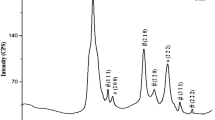Abstract
Nanocomposites prepared by mechanical mixing with grinding and mechanical activation of a mixture of Hombifine N with nanosized anatase (NA) and poly(N-vinylcaprolactam) (PVCL) polymer (PVCL25 and PVCL40 polymers were obtained by drying a PVC aqueous solution at 25 and 40°C, respectively) in different weight ratios have been studied by wide-angle X-ray scattering (WAXS) and (for the first time) small-angle X-ray scattering (SAXS). Amorphization of anatase (decrease in the average size of the coherent-scattering region), selection of X-ray amorphous hydrated titanium dioxide from the amorphous shell of anatase nanoparticles, destruction of PVCL, and disordering of its heterocycles in NA/PVCL (NA : PVCL = 1 : 1) nanocomposites upon mechanical activation have been revealed. The interaction (with water molecule exchange) between anatase, anatase, and PVCL nanoparticles during formation of NA/PVCL25 (NA : PVCL = 1 : 2) upon mechanical mixing with grinding is found to lead to segregation of anatase nanoparticles into two groups: particles with reduced and enhanced (formation of texture) degree of crystallinity (average sizes of coherent-scattering regions) in comparison with the initial anatase. SAXS made it possible to reveal structural inhomogeneities of different sizes in PVCL25 and PVCL40, which change differently upon mechanical activation, retaining the tendency to smaller sizes in PVCL25 (a coil) in comparison with PVCL40 (a globule). It is shown that the effects of mechanical activation and mechanical mixing with grinding on the components of NA–PVCL system differ, and that anatase nanoparticles play a decisive role in NA/PVCL nanocomposites, facilitating averaging of the inhomogeneity sizes upon mechanical activation. The results of studying the photocatalytic activity in the reaction of methyl orange decomposition (UV irradiation) in the presence of NA–PVCL samples indicate that it depends on the average sizes of coherent-scattering regions and is independent of the inhomogeneity sizes.






Similar content being viewed by others
REFERENCES
R. Newnham and J. F. Fernandez, Proc. Third European Ceramic Society Conference (Third Euro-Ceramics), Madrid, September 12‒17,1993 (Faenza Editrice Iberica, Madrid, 1993), Vol. 2, p. 1.
H. Gleiter, J. Weissmüller, O. Wollersheim, and R. Würschum, Acta Mater. 49 (4), 737 (2001).
J. D. Joannopoulos, Nature 414, 257 (2001).
H. Miguez, A. Blanco, C. Lopez, et al., J. Lightwave Technol. 17 (11), 1975 (1999).
G. M. Kuz’micheva, Tonkie Khim. Tekhnol. 10 (6), 5 (2015).
Yu. E. Kirsh, T. M. Karaputadze, V. I. Shumskii, et al., RF Patent No. 1613446, MPK C08F 126/06, 2/46 (July 1, 1988), Byull. Izobret., 1990, no. 46 (December 15, 1990).
I. P. Chikhacheva, O. I. Timaeva, G. M. Kuz’micheva, et al., Crystallogr. Rep. 61 (3), 421 (2016).
O. Timaeva, I. Chihacheva, G. Kuzmicheva, et al., J. Mater. Res. 33 (10), 1475 (2018).
G. M. Kuz’micheva, V. V. Podbel’skii, A. N. Stepanov, and A. A. Gainanova, Program for Processing Diffraction Patterns from Nanoscale and Amorphous Materials and Calculation of Substructure Characteristics. Government Registration Certificate for computer program No. 2017610699.
G. S. Peters, O. A. Zakharchenko, P. V. Konarev, et al., Nucl. Instrum. Methods Phys. Res. A 945, 162616 (2019).
T. C. Huang, H. Toraya, T. N. Blanton, et al., J. Appl. Crystallogr. 26 (2), 180 (1993).
A. P. Hammersley, FIT2D: An Introduction and Overview. ESRF Internal Report (1997).
P. V. Konarev, V. V. Volkov, A. V. Sokolova, et al., J. Appl. Crystallogr. 36, 1277 (2003).
P. V. Konarev, M. V. Petoukhov, V. V. Volkov, et al., J. Appl. Crystallogr. 39, 277 (2006).
M. V. Petoukhov, D. Franke, A. V. Shkumatov, et al., J. Appl. Crystallogr. 45, 342 (2012).
D. I. Svergun, J. Appl. Crystallogr. 25, 495 (1992).
D. I. Svergun, E. V. Shtykova, V. V. Volkov, et al., Crystallogr. Rep. 56 (5), 725 (2011).
E. W. Fischer, J. H. Wendorff, M. Dettermaier, et al. J. Macromol. Sci. Phys. B 12, 41 (1976).
A. A. Gainanova, G. M. Kuz'micheva, and I. G. Vasil’eva, Izv. Akad. Nauk, Ser. Khim., No. 8, 1350 (2018).
M. Dadachov, U.S. Patent Application Publication 2006/0171877 A1 (2006).
J. Teng, S. Bates, D. A. Engers, et al., J. Pharm. Sci. 99, 3815 (2010).
Guettai and H. A. Amar, Desalination 185, 427 (2005).
O. Timaeva, V. Chernyshev, G. Kuz’micheva, et al., J. Nanosci. Nanotechnol. 19, 762 (2019).
P. Scherrer, Göttinger Nachrichten Gesell. 2, 98 (1918).
W. H. Hall, Proc. Phys. Soc. (London) 62, 741 (1949).
M. Dusek, V. Petricek, and L. Palatinus, Z. Kristallogr. 229, 345 (2014).
A. V. Zhilkina, A. A. Gordienko, N. A. Prokudina, et al., Russ. J. Phys. Chem. A 87 (4), 674 (2013).
Funding
This study was supported by the Ministry of Science and Higher Education of the Russian Federation (agreement no. 4.1069.2017/PCh; 2017–2019) and performed within the State assignment for the Federal Scientific Research Centre “Crystallography and Photonics” of the Russian Academy of Sciences in the part concerning the SAXS analysis of nanoparticle size distributions.
Author information
Authors and Affiliations
Corresponding author
Additional information
Translated by Yu. Sin’kov
Rights and permissions
About this article
Cite this article
Mulakov, S.P., Konarev, P.V., Timaeva, O.I. et al. Application of X-Ray Methods for Determining the Dimensions of Nanoparticles in the Nanosized Anatase–Poly(N-vinylcaprolactam) System. Crystallogr. Rep. 65, 631–640 (2020). https://doi.org/10.1134/S1063774520040161
Received:
Revised:
Accepted:
Published:
Issue Date:
DOI: https://doi.org/10.1134/S1063774520040161



